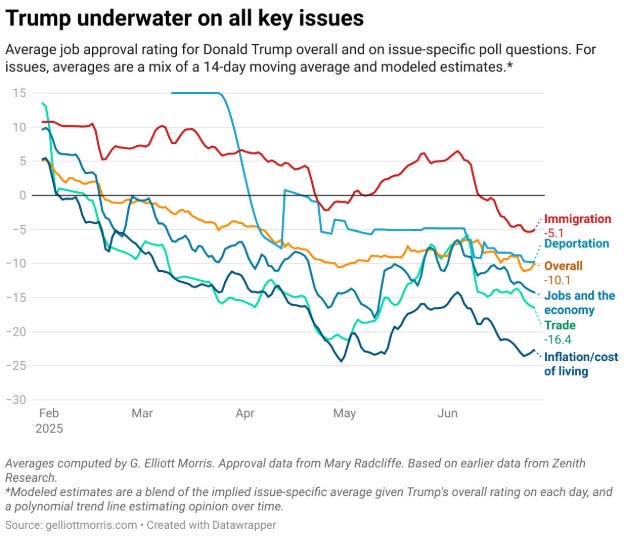It is 2025 in the USA. We have military personnel enforcing domestic law, masked, unidentified men running around and abducting people, a state building an internment camp, a Supreme Court ruling that limits courts’ ability to restrict the power of the executive, a high-level Department of Justice official encouraging DOJ officials to ignore court rulings, a prominent university president resigning under pressure from the federal executive, and elected members of Congress encouraging the president to revoke the citizenship of a political opponent they disagree with. Not to mention a political assassination that everyone has moved on from and a steady beat of economic uncertainty. “Other than that Mrs. Lincoln, how was the play?”
I have a lot more to say about all of these and why I am increasingly pessimistic (yes, even more than I have been) about the short-term future of the American system. But, I’ll push off those thoughts for a little and let’s take a look at some reasons for hope and optimism.
Trump’s approval, overall and on specific issues, is declining. Presidents are almost always most popular at the beginning of their terms and then decline from there. So, Trump’s decline is what is to be expected. The hope comes from the fact that it demonstrates Trump’s actions are not popular, no matter how many times he lies and says they are. During the protests in Los Angeles there was debate, online at least, about how this would play out in public opinion. Some people, including people I generally like, such as Tom Nichols and Jonah Goldberg, suggested that the images of protestors waving Mexican flags would play into Trump’s hands and cause the public to support Trump’s actions more than they otherwise would have. Perhaps there is some truth to that, but as you can see above, Trump’s approval on immigration took a nosedive in early June, during the LA protests.
The data shows also that a majority of the public does not believe Trump’s lies that he has inflation under control or that the tariffs will lead the U.S. into the economic promised land. The myth has always been that Trump is popular, and his opponents need to figure out why he is so popular if they want to defeat him. The reality is that a majority of Americans have always disapproved of Trump and many of his policies. The trick is to figure out how to unite that majority.
The “No Kings” protests on June 14th were pretty large and successful. Somewhere between 4 and 6 million Americans turned out to demonstrate against Trump and his actions. They were largely peaceful and a clear demonstration of the point made above; Trump and his policies are not popular. The protests also demonstrate that it is possible to motivate a large group of people to come out and speak out against the government, together. The collective action problem, how do you get a large group of people to act toward the same goal, is a crucial one in checking the power of the government. This is one of the things that Tocqueville notices about the U.S. in the early 1800s and one of the reasons he calls America the most democratic country in the world. Conversely, the lack of collective action helps solidify the power of authoritarian governments. The lack of coordinated, widespread protests prior to June 14 (other than those against Musk) could be seen as evidence the U.S. would not move against Trump’s authoritarian actions. June 14 protests help alleviate those concerns somewhat.
In the same way, the lack of support for Trump’s military parade birthday bash was also an optimistic outcome. If the situation were reversed, and the No Kings protests were poorly attended and the birthday parade was over capacity, we would truly be in the darkest timeline. But the nation’s capital appeared pretty empty and the parade pretty uninspiring. As the picture above suggests, even Trump seemingly found it less than ideal. Reportedly, Trump yelled at Hegseth afterwards at how poorly the event went. To keep our spirit of optimism, we’ll just gloss over the fact that the parade was sponsored by crypto-company Coinbase.
The Trump administration did belatedly comply with some court rulings. Mahmoud Khalil, the Columbia university protestor, was released after 104 days in detention. Kilmar Abrego Garcia, the man from Maryland who was sent to El Salvador, came back to the U.S. and will apparently face charges in a court. These have become two of the most high-profile examples of the Trump administration’s abduct, detain, and deport policies. Both won their cases in court for basic due process rights, and although Trump indicated he would not follow the courts’ orders, ultimately, he did. Perhaps this provides hope that the administration will follow future court decisions.
Finally, (and I’m grasping a little here for a fifth one) Trump’s rhetoric about Putin and Ukraine has softened a little. At the recent NATO summit, Trump said he saw Putin as the obstacle to achieving a peace. He has not said this in the past, mostly blaming Zelensky and Ukraine for failing to make peace. I think that all it will take is another call from Putin and then Trump will change his mind, but it’s still ever so slightly encouraging to hear Trump say this in public.
So, there you have it. Five reasons for hope and optimism. I am still far more pessimistic than optimistic, but if you take these five things together, you can see a path out of the mess we’re in. Trump and his policies continue to become less popular, the courts continue to rule against him and he, because of his unpopularity, he is pressured to follow the courts. Trump says a lot of crazy things with respect to foreign policy but it, more or less, continues on the same trajectory it was before he became president. He leaves office in three years, and we try to pick up the pieces of our broken politics.







